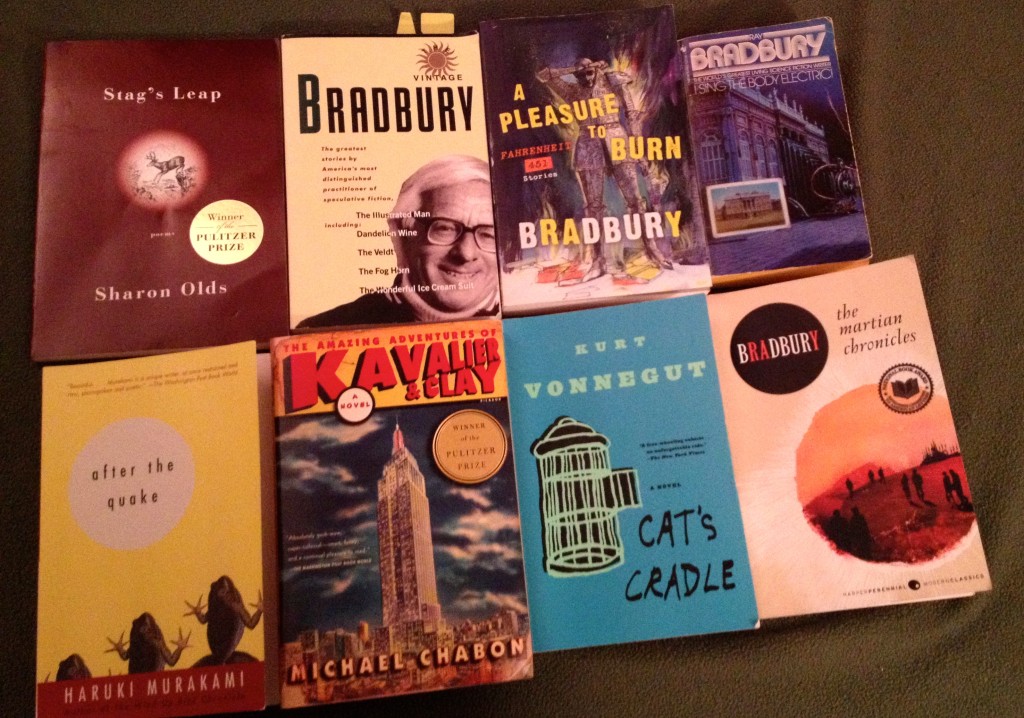After 10 weeks of staring at computer screens and code for eight to 15 hours a day during my News21 Fellowship, I decided to give my eyes a rest. I read several (paperback, bound, dust-scented) books while traveling in California and on planes. I sat for hours in coffee shops throughout the Bay Area reading, finishing books, starting another. Here’s a list of the books I completed this summer.
The Amazing Adventures of Kavalier and Clay by Michael Chabon
This unrivaled novel is a must-read. Seriously, go out immediately and buy it if you have not yet had the pleasure of reading it. The novel focuses on two Jewish cousins in 1930s New York, and their struggle to become known in the burgeoning comic book business, amidst the growing threat and then reality of the Holocaust. In one novel, Chabon seems to incorporate a collection of poems, a play, two films and of course, several comic book series. His mastery of natural dialogue pushes the novel forward. Chabon writes some of the most convincing adult protagonists I grew to love throughout the story.
The Martian Chronicles by Ray Bradbury
Bradbury’s gift for science fiction is featured in this collection of interconnected tales. The book follows Earth’s colonization of Mars, from 2030 to 2057. Bradbury easily shifts from Martian to Earth Man points of views. He seems to gain strength when describing Mars’ and Earth’s futures through a long span of time. The chronicles are hopeful, terrifying and full of grief and loss and wonder. Bradbury writes with such genuine fervor that I fully believed he was describing current and real Earth expeditions and Mars discoveries. I’m sad I was never able to meet Bradbury, but I breathe him to life by reading his words; words he clacked out on typewriters, words he thought and dreamt and debated. He’s alive with me while I read him.
Other Bradbury books I’m still working on this summer:
- The Vintage Bradbury, I Sing the Body Electric and A Pleasure to Burn (If you can’t tell, he’s one of my favorites).
Stag’s Leap by Sharon Olds
One of my first poet-loves, Sharon Olds’ strong details of her failing marriage are tragic and relatable. Her “The Father” is one of my favorite poetry collections. Olds writes with the utmost grace, candor and honesty. She shares all—the deepest parts of her uncertainty, hurt, lust and life. In sharing this with us readers, Olds becomes one of the strongest poets.
Cat’s Cradle by Kurt Vonnegut
One of the strangest books I’ve read, Cat’s Cradle is a classic Vonnegut read. While I can’t say that I understand it completely, the novel is a portrayal of the end of the world. His description of a religion called Bokononism is a superb analogy to real world religions. Vonnegut’s focus on the main character writing a book about the father of the atomic bomb is fascinating by itself, but he adds an additional apocalyptic storyline on top of that, for added amusement and bewilderment.
after the quake by Haruki Murakami
I have been meaning to read Haruki Murakami for a while. He writes with ease, but the depth of his images and characters is enough to fill the Grand Canyon. This collection of short stories surrounding the Kobe 1995 earthquake in Japan includes descriptions of real life, loss, emptiness, fear and surrealist experiences. Murakami is an essential read.
Grayson by Lynne Cox
This book was a short read and had some nice description of the ocean. But after the first few pages, it seemed to repeat the same descriptions, images and metaphors for the entirety of the book. I don’t discount the incredible swims Lynne Cox made, but this book is not one of the best I have read.
